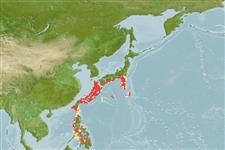>
Gadiformes (Cods) >
Macrouridae (Grenadiers or rattails)
Etymology: Nezumia: A Japanese word that means "mouse" .
More on authors: Smith & Radcliffe.
Environment: milieu / climate zone / depth range / distribution range
Écologie
marin bathydémersal; non migrateur; profondeur 355 - 910 m (Ref. 1371). Deep-water; 4°C - 8°C (Ref. 1371); 35°N - 8°N, 119°E - 143°E (Ref. 1371)
Western Pacific: southern Japan, East China Sea, and the Philippines. Distribution is probably continuous between these points.
Taille / Poids / Âge
Maturity: Lm ? range ? - ? cm
Max length : 37.0 cm TL mâle / non sexé; (Ref. 1371)
Description synthétique
Clés d'identification | Morphologie | Morphométrie
Épines dorsales (Total) : 2; Épines anales: 0. Snout short, conical, with broad, spiny terminal and lateral scutes; underside of the snout and part of the infraorbital region naked; mandibular rami with small deciduous scales posteriorly; pores large and prominent on head. Pyloric caeca 24 to 31. Body scales with long slender, conical to hastate spinules. Overall color dark brown, abdomen blackish; mouth grayish; gill cavity whitish with blackish margins; pelvic fins blackish, other fins dusky.
Life cycle and mating behavior
Maturities | Reproduction | Spawnings | Egg(s) | Fecundities | Larves
Cohen, D.M., T. Inada, T. Iwamoto and N. Scialabba, 1990. FAO species catalogue. Vol. 10. Gadiform fishes of the world (Order Gadiformes). An annotated and illustrated catalogue of cods, hakes, grenadiers and other gadiform fishes known to date. FAO Fish. Synop. 125(10). Rome: FAO. 442 p. (Ref. 1371)
Statut dans la liste rouge de l'IUCN (Ref. 130435)
Menace pour l'homme
Harmless
Utilisations par l'homme
Pêcheries: intérêt commercial mineur
Outils
Articles particuliers
Télécharger en XML
Sources Internet
Estimates based on models
Preferred temperature (Ref.
123201): 7.1 - 11.9, mean 9 °C (based on 35 cells).
Phylogenetic diversity index (Ref.
82804): PD
50 = 0.5000 [Uniqueness, from 0.5 = low to 2.0 = high].
Bayesian length-weight: a=0.00219 (0.00111 - 0.00431), b=3.20 (3.03 - 3.37), in cm total length, based on LWR estimates for this (Sub)family-body shape (Ref.
93245).
Niveau trophique (Ref.
69278): 3.3 ±0.1 se; based on size and trophs of closest relatives
Résilience (Ref.
120179): Faible, temps minimum de doublement de population : 4,5 à 14 années (Preliminary K or Fecundity.).
Fishing Vulnerability (Ref.
59153): Low to moderate vulnerability (27 of 100).
